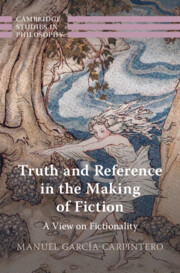Refine search
Actions for selected content:
642 results
4 - Cultural Exchanges
-
- Book:
- Cold War Comrades
- Published online:
- 25 December 2025
- Print publication:
- 08 January 2026, pp 156-197
-
- Chapter
- Export citation

Truth and Reference in the Making of Fiction
- A View on Fictionality
-
- Published online:
- 18 December 2025
- Print publication:
- 22 January 2026
Introduction
-
- Book:
- American Performance in 1976
- Published online:
- 27 November 2025
- Print publication:
- 11 December 2025, pp 1-43
-
- Chapter
-
- You have access
- HTML
- Export citation
Chapter 1 - Adrienne Kennedy and Cecil Taylor
-
- Book:
- American Performance in 1976
- Published online:
- 27 November 2025
- Print publication:
- 11 December 2025, pp 44-103
-
- Chapter
- Export citation

American Narrative Realism
- The Novel, Film, Television, and Theater
-
- Published online:
- 17 November 2025
- Print publication:
- 04 December 2025
Brassage on Film: Late Colonialism in French Africa and Race-Making in Postcolonial France in the Work of Jean Rouch
-
- Journal:
- Itinerario , First View
- Published online by Cambridge University Press:
- 10 November 2025, pp. 1-17
-
- Article
-
- You have access
- Open access
- HTML
- Export citation
1 - Introduction: The Personal Is Political – How I Came to Write This Book
-
- Book:
- Tied Up in Tehran
- Published online:
- 28 September 2025
- Print publication:
- 16 October 2025, pp 1-23
-
- Chapter
- Export citation
7 - Through the Looking Glass: Reflexive Cinema and Society in Postrevolutionary Iran
-
- Book:
- Tied Up in Tehran
- Published online:
- 28 September 2025
- Print publication:
- 16 October 2025, pp 142-184
-
- Chapter
- Export citation
Chapter 31 - Pierre Boulez at the BBC
- from Part V - Multiple Activities
-
-
- Book:
- Boulez in Context
- Published online:
- 08 July 2025
- Print publication:
- 24 July 2025, pp 320-326
-
- Chapter
- Export citation
Chapter 31 - The Biography in Performance
- from Part IV - Performance Legacies
-
-
- Book:
- Sean O'Casey in Context
- Published online:
- 23 June 2025
- Print publication:
- 10 July 2025, pp 340-350
-
- Chapter
- Export citation
Chapter 6 - ‘Temporarily Sane’: Beckett and Modernist Suicide
-
- Book:
- Samuel Beckett and Medicine
- Published online:
- 20 June 2025
- Print publication:
- 03 July 2025, pp 117-134
-
- Chapter
- Export citation
23 - The Holocaust and Film
- from Part IV - Culture and Fields
-
-
- Book:
- The Cambridge History of the Holocaust
- Published online:
- 16 May 2025
- Print publication:
- 12 June 2025, pp 539-558
-
- Chapter
- Export citation
Film, narrative agency, and the politics of care in veteran Britain
-
- Journal:
- Review of International Studies , First View
- Published online by Cambridge University Press:
- 29 April 2025, pp. 1-18
-
- Article
- Export citation
Chapter 40 - Shelley and Popular Culture
- from Part IV - Afterlives
-
-
- Book:
- Percy Shelley in Context
- Published online:
- 17 April 2025
- Print publication:
- 24 April 2025, pp 309-316
-
- Chapter
- Export citation
Saludos Amigos. Disney Propaganda for Latin America
-
- Journal:
- The Americas / Volume 82 / Issue 2 / April 2025
- Published online by Cambridge University Press:
- 30 June 2025, pp. 219-247
- Print publication:
- April 2025
-
- Article
-
- You have access
- Open access
- HTML
- Export citation
Chapter 6 - The Double in Film
-
- Book:
- Doppelgänger
- Published online:
- 13 March 2025
- Print publication:
- 20 March 2025, pp 106-126
-
- Chapter
- Export citation
Debating Shusenjo - the Main Battlefield of the Comfort Women Issue: Director Miki Dezaki in conversation with Mark R. Frost and Edward Vickers
-
- Journal:
- Asia-Pacific Journal / Volume 19 / Issue 5 / March 2021
- Published online by Cambridge University Press:
- 14 March 2025, e11
-
- Article
-
- You have access
- Open access
- Export citation
Vicarious Politics: Violence and the Colonial Period in Contemporary South Korean Film
-
- Journal:
- Asia-Pacific Journal / Volume 15 / Issue 12 / June 2017
- Published online by Cambridge University Press:
- 14 March 2025, e3
-
- Article
-
- You have access
- Open access
- Export citation
Notes Toward an Archaeology of Hallyu
-
- Journal:
- Asia-Pacific Journal / Volume 15 / Issue 14 / July 2017
- Published online by Cambridge University Press:
- 14 March 2025, e3
-
- Article
-
- You have access
- Open access
- Export citation
Chapter 7 - Videos and Animations
-
- Book:
- Technological Innovations in Participatory Health Research with Adolescents
- Published online:
- 20 February 2025
- Print publication:
- 27 February 2025, pp 139-151
-
- Chapter
- Export citation
